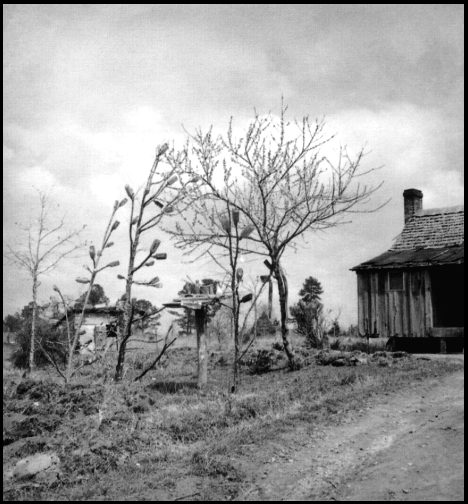Finally arranged an evening with H. and the kids and saw "Ray: Unchain My Heart" last night. Excellent movie - Jamie Foxx and Sharon Warren were wonderful - but I kept wondering about the looming presence of the colorful bottle tree. What does a bottle tree symbolize?
Fortunately the subject has won some attention. Old cobalt blue bottles, the 19th Century sort one sometimes finds in the ruins of old Western ghost towns, are the favored decoration:
The unusual trees originated as an ancient African custom that can be traced back as far as ninth century Congo. Natives hung hand-blown glass on trees to ward off evil. The tradition migrated to the United States and became part of the Southern African-American folklore.
Many items and symbols were used in a decorative manner, but each had a very significant meaning. The most well-known was nailing a horseshoe above the threshold for good luck. Other examples include tacking a Bible verse above the door, or painting the doors and windows blue, or "haint blue" as it was known among those who used it. Some hung "ghost mirrors" beside the door, believing that evil is repelled by its own sight.
The trees served a significant role in the yard spaces of African-American communities as they were used as a means of protecting the home by trapping evil spirits within the colorful bottles. The bottles, usually blue, were stuck onto the protruding limbs of a tree, usually cedar, because its branches point toward the heavens.
Additionally:
According to old Southern folk beliefs, the color blue wards off evil and brings good luck. I'm not sure why the other colors were used, but maybe they are just in case some evil spirits are color blind. Some folk go even father to capture the spirits by greasing the throats of the bottles with fat to better entrap the evil spirits. Once sucked inside, it is believed that the spirits cannot escape, the morning sun seals them inside. When a strong wind whips through the bottle tree causing it to emit a low whistle or moan, that signifies the death of the imprisoned spirits. During the 1878 yellow fever epidemic in Memphis, Tennessee, families where the disease was raging hung blue medicine bottles on tree limbs outside their homes to ward off spirits associated with the plague.
Here is a photo of bottle trees from the Eudora Welty Collection:

© Eudora Welty Collection - Mississippi Department of Archives and History
Welty used bottle trees in her short story "Livvie," which was set near the Old Natchez Trace, a famous colonial "road" used by Indians, merchants, soldiers, and outlaws between Natchez and Nashville, Tennessee. This photograph, like many others taken by Welty during her work for the Works Progress Administration in the 1930s, appears in One Time, One Place: Mississippi in the Depression: A Snapshot Album (Jackson: University Press of Mississippi, 1996).
Bottle Tree as a Home Improvement project
No comments:
Post a Comment